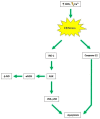The Role of Endothelial Dysfunction in Peripheral Blood Nerve Barrier: Molecular Mechanisms and Pathophysiological Implications
- PMID: 31226852
- PMCID: PMC6628074
- DOI: 10.3390/ijms20123022
The Role of Endothelial Dysfunction in Peripheral Blood Nerve Barrier: Molecular Mechanisms and Pathophysiological Implications
Abstract
The exchange of solutes between the blood and the nerve tissue is mediated by specific and high selective barriers in order to ensure the integrity of the different compartments of the nervous system. At peripheral level, this function is maintained by the Blood Nerve Barrier (BNB) that, in the presence, of specific stressor stimuli can be damaged causing the onset of neurodegenerative processes. An essential component of BNB is represented by the endothelial cells surrounding the sub-structures of peripheral nerves and increasing evidence suggests that endothelial dysfunction can be considered a leading cause of the nerve degeneration. The purpose of this review is to highlight the main mechanisms involved in the impairment of endothelial cells in specific diseases associated with peripheral nerve damage, such as diabetic neuropathy, erectile dysfunction and inflammation of the sciatic nerve.
Keywords: Blood Nerve Barrier (BNB); diabetic neuropathy; endothelial dysfunction; erectile dysfunction; neuropathic pain; nitric oxide; nitric oxide synthase (NOS); peripheral nerve injury.
Conflict of interest statement
The authors declare no conflict of interest.
Figures





Similar articles
-
Blood-nerve barrier dysfunction contributes to the generation of neuropathic pain and allows targeting of injured nerves for pain relief.Pain. 2014 May;155(5):954-967. doi: 10.1016/j.pain.2014.01.026. Epub 2014 Feb 3. Pain. 2014. PMID: 24502843
-
Blood-Nerve Barrier (BNB) Pathology in Diabetic Peripheral Neuropathy and In Vitro Human BNB Model.Int J Mol Sci. 2020 Dec 23;22(1):62. doi: 10.3390/ijms22010062. Int J Mol Sci. 2020. PMID: 33374622 Free PMC article. Review.
-
Early alterations of Hedgehog signaling pathway in vascular endothelial cells after peripheral nerve injury elicit blood-nerve barrier disruption, nerve inflammation, and neuropathic pain development.Pain. 2016 Apr;157(4):827-839. doi: 10.1097/j.pain.0000000000000444. Pain. 2016. PMID: 26655733
-
Selective blood-nerve barrier leakiness with claudin-1 and vessel-associated macrophage loss in diabetic polyneuropathy.J Mol Med (Berl). 2021 Sep;99(9):1237-1250. doi: 10.1007/s00109-021-02091-1. Epub 2021 May 21. J Mol Med (Berl). 2021. PMID: 34018017 Free PMC article.
-
Biology of the blood-nerve barrier and its alteration in immune mediated neuropathies.J Neurol Neurosurg Psychiatry. 2013 Feb;84(2):208-12. doi: 10.1136/jnnp-2012-302312. Epub 2012 Dec 13. J Neurol Neurosurg Psychiatry. 2013. PMID: 23243216 Review.
Cited by
-
Involvement of Fatty Acids and Their Metabolites in the Development of Inflammation in Atherosclerosis.Int J Mol Sci. 2022 Jan 24;23(3):1308. doi: 10.3390/ijms23031308. Int J Mol Sci. 2022. PMID: 35163232 Free PMC article. Review.
-
Amyloid Proteins and Peripheral Neuropathy.Cells. 2020 Jun 26;9(6):1553. doi: 10.3390/cells9061553. Cells. 2020. PMID: 32604774 Free PMC article. Review.
-
From Metabolic Syndrome to Neurological Diseases: Role of Autophagy.Front Cell Dev Biol. 2021 Mar 19;9:651021. doi: 10.3389/fcell.2021.651021. eCollection 2021. Front Cell Dev Biol. 2021. PMID: 33816502 Free PMC article. Review.
-
IGFBP5 antisense and short hairpin RNA (shRNA) constructs improve erectile function by inducing cavernosum angiogenesis in diabetic mice.Andrology. 2023 Feb;11(2):358-371. doi: 10.1111/andr.13234. Epub 2022 Aug 7. Andrology. 2023. PMID: 35866351 Free PMC article.
-
Cell Heterogeneity and Variability in Peripheral Nerve after Injury.Int J Mol Sci. 2024 Mar 20;25(6):3511. doi: 10.3390/ijms25063511. Int J Mol Sci. 2024. PMID: 38542483 Free PMC article. Review.
References
-
- Maiuolo J., Gliozzi M., Musolino V., Scicchitano M., Carresi C., Scarano F., Bosco F., Nucera S., Ruga S., Zito M.C., et al. The “Frail” Brain Blood Barrier in Neurodegenerative Diseases: Role of Early Disruption of Endothelial Cell-to-Cell Connections. Int J. Mol. Sci. 2018;19:2693. doi: 10.3390/ijms19092693. - DOI - PMC - PubMed
-
- Pelz J., Härtig W., Weise C., Hobohm C., Schneider D., Krueger M., Kacza J., Michalski D. Endothelial Barrier Antigen immunoreactivity is Conversely Associated with Blood-Brain Barrier Dysfunction after Embolic Stroke in Rats. Eur J. Histochem. 2013;57:255–261. doi: 10.4081/ejh.2013.e38. - DOI - PMC - PubMed
-
- Flammer A.J., Anderson T., Celermajer D.S., Creager M.A., Deanfield J.D., Ganz P., Hamburg N., Lüscher T.F., Shechter M., Taddei S., et al. The Assessment of Endothelial Function- From Research into Clinical Practice. Circulation. 2012;126:753–767. doi: 10.1161/CIRCULATIONAHA.112.093245. - DOI - PMC - PubMed
Publication types
MeSH terms
Substances
Grants and funding
LinkOut - more resources
Full Text Sources
Medical

